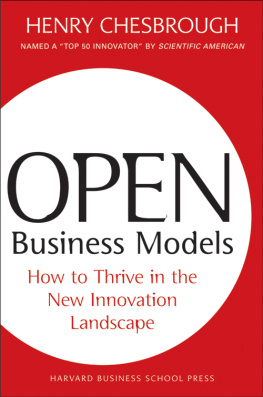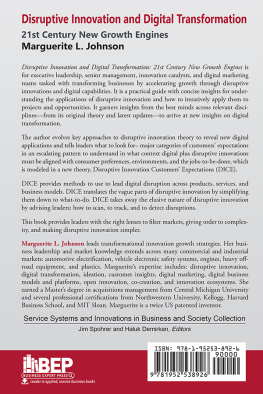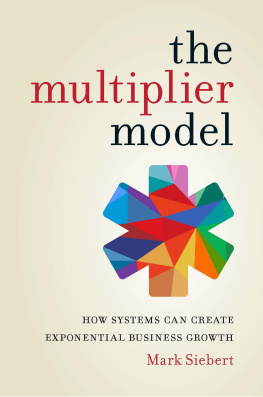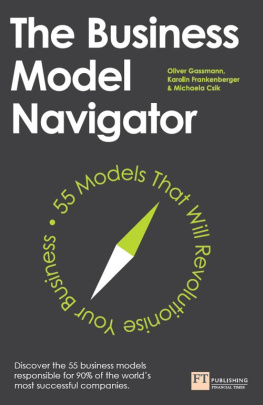Copyright 2010 Mark W. Johnson
All rights reserved
No part of this publication may be reproduced, stored in or introduced into a retrieval system, or transmitted, in any form, or by any means (electronic, mechanical, photocopying, recording, or otherwise), without the prior permission of the publisher. Requests for permission should be directed to , or mailed to Permissions, Harvard Business School Publishing, 60 Harvard Way, Boston, Massachusetts 02163.
First eBook Edition: February 2010
ISBN: 978-1-4221-2481-9
Companies which introduce new business models to their industry are able to take advantage of enormous opportunities. In Seizing the White Space, Johnson gives businesses the critical tools they need to develop new ways of bringing value to customersand to make those opportunities a reality.
Reed Hastings, founder and CEO, Netflix
Bringing innovations successfully to market is as much about leadership as technical prowess. Mark Johnson has taken innovation out of the R&D lab and put it squarely where it belongsin the executive suite. Any leader looking for growth from innovation will find new insights and practical tools in this book.
Susan Marcinelli, Senior Vice President, Innovation and Leadership Development, Best Buy
Raising the ambitions of companies and leaders is the key to making any business model transformation process work. Johnson provides unique examples and insights that will make you think in new ways. A must-read.
Arkadi Kuhlmann, President and CEO, ING Direct, and coauthor, The Orange Code
I know from my own experience how difficult it is to build a new business model within an established organization, where it is hard to shed the traditional mores and structures to effect real change. It would have been great to have Johnsons bookSeizing the White Space will be a valuable tool for anyone who wants to reshape a business.
Bill Hambrecht, Chairman, WR Hambrecht + Co.
For my mother, Adriana, who taught me by
example all the important things
And for my beloved wife, Jane, and my children,
Kristina, Mark, Kathryn, Ella, and William.
They remind me every day what matters most
The shift from oral to written speech is essentially a shift from sound to visual space Because print controlled not only what words were put down to form a text but also the exact situation of the words on the page and their spatial relationship to one another, the space itself on a printed sheetwhite space as it is calledtook on high significance that leads directly into the modern and post-modern world.
Walter Ong
Since its beginning as a partnership between a candle maker and a soap manufacturer in 1837,Procter & Gamble has been a product innovator. Ivory (the soap that floats) was invented in 1879; Dreft, the first synthetic laundry detergent,in the depths of the Depression in 1933; Tide, the first heavy-duty laundry detergent, in 1946; Crest, the first ADA-approved fluoride toothpaste, in 1955. Pampers, the first disposable diaper, was introduced in 1961; Pert Plus, the first combined shampoo and conditioner, in 1986; the Febreze fabric freshener and Swiffer mop in 1998; Crest Whitestrips, the first mass-market in-home tooth-whitening system, in 2001.
So its not surprising that most people think the secret to P&Gs success has been steady product innovation. But to grow on the scale that P&G does for as long as we have requires more than steady growth in core markets. It requires changes to what Mark Johnson calls in this book something more core than core. It requires innovation in P&Gs basic business modelsthat is, changes to the way we turn a profit, to the value propositions we offer our customers, to the way we combine our internal and external processes to go to market. Innovations like those we made in 1919, when we hired 450 sales representatives to sell directly to retailers rather than through wholesalers; or in 1924, when we set up the first market research department to understand changing trends in consumer demand; or in 1931, when we introduced the notion of fielding competing brands in the same category; or today, as we move into high-frequency stores in developing countries.
Over its history, in fact, P&G has reinvented itself about once a decade to respond to changes in consumer and market realities and to tackle barriers to realizing transformational growth opportunities. Innovation was among my top priorities during the nine years I served as P&Gs CEO, and it remains a critical priority for Bob McDonald, who succeeded me. Over the course of my career, Ive come to see business model innovation not as a static process but as a systemic, repeatable, and reliable capability, one that leaders need to build, strengthen, and eventually turn into a sustainable competitive advantage.
But how? Business model innovation has become a popular buzz phrase in the business press and in academia in recent years. Yet to my mind, it is a topic that few people understand at any rigorous level, and as a result its not being accorded the importance it should have in most corporate and business-unit strategy processes.
Thats why this book is so welcome. In Seizing the White Space, Johnson lays out a compelling case for business model innovation as the catalyst for robust growth, both through transformation of existing marketsthe white space within that every company hasand through the creation of tomorrows new marketsthe white space beyond that so many companies find so hard to venture into.
It is welcome because Johnson has done the hard work of distilling just what a business model consists of: His interdependent four-box business model framework is a powerful synthesis, built from careful study of companies spanning a wide range of industries. Equally important is his insight into just how relative white space is. One companys white space is anothers home turf. That was an insight we used to great advantage at P&G, for example as we expanded Swiffera core product for usinto totally new markets where it represents a fundamentally new business model for our competitors.
Johnsons model sheds light on two areas that I have seen derail the best of managements intentions to seize white space. Ive known situations in which we could identify new customer value propositions but were late to market, and times when we had conceived innovative new profit models but failed to commercialize them successfully. We were unable to put the right resources, external partners, or internal activity systems into place for those types of discontinuous innovation opportunities.
Reinvention at that level requires first that you know what business youre in. The four-box modelcustomer value proposition, profit formula, key resources, and key processesmakes the sources of a businesss current success explicit. By extension, it identifies which ones need to change if a company is to capitalize on a new opportunity. Seizing the White Space provides top executives and innovation leaders with a comprehensive but user-friendly approach to making new-value creation a consistent, repeatable process.
Seizing white space is hard. It requires looking at markets and customers in new ways. It requires an openness to experimentation and uncertainty. It requires a willingness to challenge and change those well-honed systems and models that made your enterprise successful in the first place.
In recent years, Procter & Gamble has pursued three clear growth strategies: continue to grow the core business with leading brands in big, growing retail markets; develop fast-growing, higher-margin global businesses; and grow disproportionately in developing markets. On the face of it, these strategies might look like simply staying the course for a large, packaged goods company. But delivering on those strategies required significant changes to the business model P&G had been operating under for decades.









